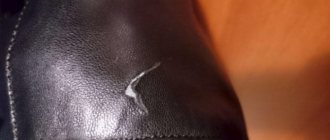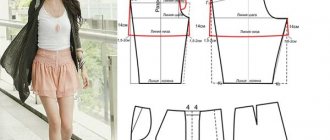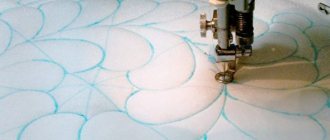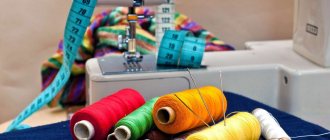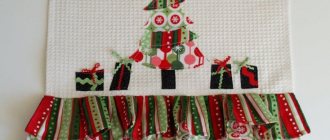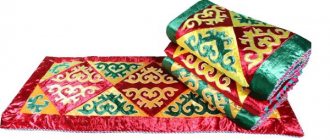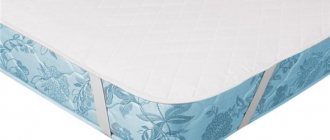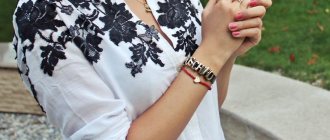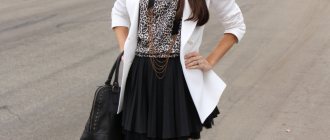How to work with leather? How to sew a leather jacket correctly? You can think and reflect on this topic for a long time, or you can take it and sew a leather jacket with your own hands. As they say: “Until you try it yourself, you won’t know!” Genuine leather is a noble material that is also practical and durable. Things made from genuine leather are much more highly valued compared to artificial ones. Have you noticed that a leather jacket fits better on your figure than a regular one?! And after several times of use, it takes on the contours of your figure.
Genuine leather is an organic material, so its properties provide excellent fit, comfort, chic and versatility. A leather jacket can be combined with any thing and it will always be a winner, and the image will become unique. In this article I want to share my experience on how to sew a leather jacket with my own hands and give some useful examples. In this case, we will consider sewing a men's jacket made of genuine leather for a athletic figure.
Exclusive. Biker jacket. Instructions for sewing and printing patterns
Women's jacket, interseasonal, fitted silhouette, 15-20 cm long below the waist line.
The jacket is lined, stitched along the bottom line. The shelf with an offset side fastener with a zipper braid consists of a central, middle and side part. The middle parts of the shelf have framed welt pockets fastened with a zipper. On the right shelf there is an upper finishing (non-functional) pocket with a frame. Back with detachable side parts. The lower section of the jacket is finished with a stitched belt.
Turn-down collar with a detachable stand. Two-seam set-in sleeve. The elbow seam of the sleeve has a vent that is fastened with a zipper. Shoulder straps are inserted into the seam of the sleeves, fastened at the shoulder seams with a button.
Difficulty level: medium, experience required.
Constructive increases: to chest circumference – 12 cm up to size 52, 15 cm starting from size 54; to waist circumference 10 cm; to hip circumference – 5 cm up to size 52, 6-7 cm starting from size 54.
Materials: the product can be made from natural or artificial leather, suede, duplicated knitted fabric, jacket or coat fabric, etc. For the lining you will need any lining material in a color combination with the main material.
When ordering a pattern you receive 3 pdf files:
- A file with instructions for printing a pattern, containing a control square and the measurements according to which the pattern was constructed;
- File with pattern in A4 format, for printing on a regular printer
- File with a pattern on one large sheet - for printing on a plotter
Pattern sample:
* PRINTING ON A4 FORMAT PRINTER:
*PRINTING ON A PLOTTER:
When printing a pattern on a plotter, open the pattern file in Adobe Reader (or Foxit Reader). Click on the "File" menu item, then select "Print". Select the Poster print mode under Page Sizing and Handling. Make sure the Segment Scale field is set to 100%. Check the boxes for Cutting Marks, Shortcuts, and Split Large Pages Only.
The following designations are used on the pattern:
Parts Specification
- Back – 1 piece (with fold)
- Lower part of the back – 1 piece (with fold)
- The middle part of the shelf – 2 parts
- The central part of the shelf and the border - 4 parts
- Cut-off side part of the shelf - 2 parts
- Cut-off side part of the back - 2 parts
- Front part of the sleeve – 2 parts
- Back (elbow) part of the sleeve – 2 parts
- Belt and waistband facing – 4 parts
- Collar – 2 parts
- Collar stand – 2 parts
- Hemming of the bottom line of the back - 1 piece (with fold)
- Shoulder strap – 4 parts
- Finishing a welt pocket into a frame – 4 parts
- Valance of welt pocket in frame – 2 parts
- Finishing the top pocket into a frame – 2 parts
- Valance of welt pocket in frame – 1 piece
- Wedge insert into the sleeve section - 2 parts
Attention! When cutting, add 10mm seam allowances along all cuts.
To make the product you will need 1.3-1.5 m of base material, depending on size and height, 1.2-1.3 m of lining material with a width of at least 1.5 m.
Layout of cutting details
Attention! In the technological sequence, the processes for duplicating parts are not indicated, since the need to use adhesive methods is determined by the properties of the material.
Technological sequence for processing a sports jacket
- Sew the bottom of the back to the top. Press the seam allowance towards the bottom and sew a finishing stitch along the seam.
- Hem the edge of the side of the right shelf, inserting a zipper under the stitching.
- Stitch the edge of the left shelf edge.
- Hem the top edge (ledge) of the front lapel. Turn the corner right side out and iron it.
- Finish the welt pockets into a frame.
— please check that the pocket application parts are cut correctly (Fig. 1).
Attention! The blue outline indicates the original line of the part, and the black outline indicates the outline of the part being cut out of the material. The width of the seam allowance is 10-12 mm.
- draw the stitching lines for the facings on the shelf (these are the lines that are marked as dotted lines on the pattern);
- iron the facings in half lengthwise;
- baste and then stitch the facings to the front along the marked lines (Fig. 2, lines 1 and 2);
- cut the entrance to the pocket and turn the facings right side out;
- sew the zipper tape to the seam allowances for the facings (Fig. 2, lines 3 and 4);
- secure the corners of the pocket;
- Stitch the smaller piece of pocket burlap to the seam allowance for stitching the bottom facing to the front (Fig. 2, line 5);
- Stitch the pocket valance to the seam allowance of stitching the top facing to the front (Fig. 2, line 6);
- sew a finishing stitch along the contour of the pocket (Fig. 2, line 7);
- sew the smaller piece of pocket burlap to the valance along the bottom edge (Fig. 2, line 8);
- sew the burlap parts on three sides
Attention! If the lining material is fraying, then the seam allowances need to be overcast
- Baste and then stitch the cut side piece of the front to the middle piece. Press seam allowances.
- Turn the facing edge right side out and press.
- Baste and then stitch the cut side back piece to the side front piece. Press seam allowances.
- Sew the waistband to the front along the bottom edge. Press the seam allowances toward the waistband and sew a finishing stitch along the seam.
- Baste and then stitch the center part of the right front to the middle one. Press seam allowances.
- Baste and then stitch the center part of the left front to the middle one, inserting the second part of the detachable zipper.
- Process the top finishing pocket “in the frame” of the right shelf.
Attention! Processing the pocket is similar, but lines 5, 8 and 9 are not performed, i.e. All operations associated with stitching the pocket burlap parts must be skipped.
- Baste and then stitch the cut side back piece to the middle back piece. Press the seam allowances towards the cut side part.
Collar and shoulder strap preparation
- Sew the top collar stand to the top collar. Press and stitch seam allowances.
- Stitch the bottom collar stand to the bottom collar. Press and stitch seam allowances.
- Stitch the top collar with the bottom one along the flap. First press the seam allowance and then press it towards the bottom collar.
- Stitch the ends of the collar. Press seam allowances. Turn the collar right side out and iron it ready. (This processing sequence is optimal from the point of view of ensuring symmetry of the ends of the collar).
- Sew a finishing stitch along the collar.
Lifesaver - egg white
If you don’t have any of the above remedies at home, and you need to restore the jacket as quickly as possible, you can use egg white. To do this, carefully separate the yolk from the white so as not to spoil the item with the composition and not to take your leather jacket for repair. Beat the egg whites until they form a stable foam; it is most convenient to do this with a mixer.
Soak a rag in the resulting mixture and apply it to the jacket.
Note! When choosing a place for this procedure, keep in mind that protein may drip onto the floor during and after rubbing.
After the entire surface of the jacket has been treated, leave it for 4 hours. After the time has passed, wipe off any unabsorbed protein and leave the jacket to dry.
The main rules for sewing a jacket made of genuine leather
How to work with leather? How to sew a leather jacket correctly? You can think and reflect on this topic for a long time, or you can take it and sew a leather jacket with your own hands. As they say: “Until you try it yourself, you won’t know!” Genuine leather is a noble material that is also practical and durable. Things made from genuine leather are much more highly valued compared to artificial ones. Have you noticed that a leather jacket fits better on your figure than a regular one?! And after several times of use, it takes on the contours of your figure.
Genuine leather is an organic material, so its properties provide excellent fit, comfort, chic and versatility. A leather jacket can be combined with any thing and it will always be a winner, and the image will become unique. In this article I want to share my experience on how to sew a leather jacket with my own hands and give some useful examples. In this case, we will consider sewing a men's jacket made of genuine leather for a athletic figure.
Bringing back the shine
The last step in restoring a jacket is bringing back the shine. If you are planning to apply it at home, you can safely proceed. The procedures are simple, anyone can do them.
To restore the shine to the jacket, you need to take 2 egg whites, shake and apply to the surface with a sponge.
Ground coffee will make your skin glow. This method is used only for dark material. The coffee grounds are collected in a woolen or flannel cloth and rubbed on the leather surface.
Another way is to rub clothes with laundry soap dissolved in warm water with the addition of a few drops of glycerin.
Castor oil also has a rejuvenating effect. First, the item is cleaned from dust with soapy water or ammonia. Then the sponge is soaked in castor oil and the entire product is rubbed.
Choosing skins for a leather jacket
Before you start sewing a jacket made of genuine leather, you need to decide on the choice of material. There are a lot of varieties of leather, it all depends on the manufacture and processing. Modern technologies make it possible to obtain high quality natural leather, elastic and in a variety of colors. In my case, these are kid skins, they are very soft and thin in thickness.
After selecting the skins, you should decide on their quantity. To do this, you need to prepare a pattern in advance, taking into account the style, all decorative details and the size of the figure. Then lay out the pattern (in the store) on the skins. This way you will understand how much bottom material it takes to make a jacket. Don’t forget also about the lower parts: hem, lower collar, facings, etc.
Storage
Proper storage of leather jackets will prevent rapid deterioration of the material. Use a wide, sturdy hanger. Store in a cool, dry place away from direct sunlight.
Avoid places with high humidity, such as a closet next to a bathroom. If dust quickly accumulates on your jacket, cover it with a garment bag.
Never place a leather item in a plastic bag - moisture may accumulate and mold may grow.
Avoid ironing if possible. If you need to use an iron, set the temperature to the lowest setting and iron through the fabric. An iron that is too hot will leave marks on the leather.
Despite the effectiveness of the above methods of cleaning and restoring color, the main guarantee of the longevity of leather items is regular care and adherence to simple rules that help prevent damage to the material.
Cut the jackets
After purchasing the material, we move on to cutting the jacket. Before cutting, outline with chalk areas of holes, unpainted areas, defects, etc. If the skins are in limited quantities, then the places with the least expressive defects can be used for the lower parts where they are not noticeable. The details of the pattern are cut out on the skins in the longitudinal direction, along the ridge. At this point the skins are less extensible than in the transverse direction. It is better to outline the patterns with chalk or a special pencil for leather. The handle leaves marks on the front side. You should cut from the front side, so defects on the skins are immediately visible and you can work around them.
The strongest part of the skin is the area along the ridge, so try to cut out parts that are subject to the greatest stress in these places. The abdominal area of the skin, i.e. on the sides, more delicate, it can be used for small finishing parts and in places where the load is less great. If you have a large amount of material, then this area can be completely excluded.
Idea. Creative sources
The idea to make an exaggerated leather biker jacket with a voluminous skull, decorated with appliqués of embroidered flowers and holnitens, came to me personally after seeing a leather jacket from the luxury brand “Philipp Plein” in TsUM. The jacket caught my eye because it was very fancy: embroidery, rivets, skulls, and even rhinestones. It was the rhinestones that I didn’t like. I love rhinestones, but not in everyday life. And the second factor that I didn’t like was its exorbitant cost - 370,000 rubles, which not every girl can afford. Having tried on the “Philipp Plein” biker jacket, I decided to sew a jacket in the same style, but changing some details and, above all, the shape. I decided to make an oversized model.
I really like the video of the foreign singer Kovacs “50 Shades of black”. There a girl dances in a leather jacket, as if “from someone else’s shoulder,” and in big boots. I decided to make the shape of my biker jacket just as exaggerated.
Preparing for the first fitting
After all the details are cut out, it is necessary to try on. Some sources write that before cutting, you should make a mock-up of the product from simple fabric and only then transfer the finished template to the material. This is done for high-quality tailoring, since the leather cannot be basted; punctures from the needle remain on it. Therefore, all changes are made to the layout and the product is cut out from the finished parts, which is sewn directly under the machine. But if you are confident in your experience and the accuracy of the pattern, then making a mock-up can be avoided. In addition, there are very soft and thin skins on which punctures from needles do not remain at all. Test this on a small piece of paper in advance.
You can prepare the product for fitting without removing the details, for example, by joining it with a stapler, tape or a special adhesive pencil for leather that does not leave marks.
How to properly try on a product, read the link.
Removing tears
Before updating a leather jacket at home, it is worth finding out what kind of defects are present on the product. It often happens that outer clothing is torn or frayed. A scratch or hole is not a death sentence for a leather product. The problem area can be sealed; for this, “Liquid Skin” is used. To carry out the work, you will need not only the product itself, but also a bandage and a small spatula (you can take an old plastic card instead). To restore the skin and eliminate tears, you need to adhere to the following algorithm:
- Cut a piece from the bandage; its dimensions should be slightly larger than the defect.
- Apply adhesive to the deformed area, apply a bandage, and press firmly.
- Using a spatula, apply “Liquid Leather”, evenly distributing the composition over the canvas.
- Allow the patch to dry for 15 minutes, then repeat the procedure again.
When the work is completed, the jacket can be left on its hangers. Complete drying occurs in 3-4 hours, but for the first couple of days it is not recommended to wear the item in rainy weather.
Cut a piece from the bandage to fit the hole
Apply a bandage to the deformed area
Apply “Liquid Skin”, let dry, repeat the procedure
Leave to dry
Sewing a jacket
After fitting, the seams are sewn down using a Teflon foot; a regular foot does not fit; it does not slide on the skin.
Then the seams are pressed or ironed, depending on the model, and the allowances are fixed with glue.
The glue for such cases is only suitable for leather; other glues roughen the seams when they dry. If necessary, the glue can be easily removed with acetone. To reduce the thickness of the seam, the seams are carefully pounded with a hammer. If you need to add finishing stitches along the seams, also use a Teflon foot. Choose threads and needles depending on the type of leather, as well as the processing and model of the product. The finishing stitch width is recommended from 4.0 mm. , it depends on the model and your wishes. Do not use machine fastenings on leather to prevent the stitching from unraveling; cut the threads, leaving 0.5 cm , and singe the ends. The main feature of leather jackets is a lot of decorative finishing, for example, small details, figured seams, metal rivets and zippers. Genuine leather can be combined with various fabrics: knitwear, guipure, chiffon, drape, etc.
Taking measurements, building a structure
I needed the following measurements:
- OG - chest circumference
- OT - waist circumference
- OB - hip circumference
- Opl - shoulder circumference
- WZp - wrist circumference
- DlR - arm length
- Ll—product length
- ShSp - back width.
After taking measurements, I built the design of the jacket and modeled its shape. This all needs to be done before purchasing leather, otherwise you will not know how much leather to buy. I decided to make the jacket longer than the classic biker jacket. Accordingly, you need to buy more leather for this.
How to iron natural leather?!
Iron natural leather very carefully at low temperatures without steam using a dry iron, both on the front and back sides. Excessive moisture and heat will lead to deformation of skin areas. On a separate patch, check the skin for sensitivity to heat treatment.
Helpful Tips:
- After finishing the work, all chalk lines can be easily removed with a damp cloth, and the appearance is created using a can of leather paint.
- When cutting a men's leather jacket, you need to take into account the activity in the shoulder girdle. Therefore, larger increases are made in the chest and back width than in the waist and hips. Also, the amount of increase depends on the thickness of the lining and the clothing worn under the jacket.
- Lining for leather jackets, choose from natural fabrics or containing natural fibers. Since it is synthetic, it does not allow air to pass through well, which increases sweating.
- Sewing genuine leather should be done on a production machine; household machines have a weak motor, which will lead to breakage or poor quality sewing of the product.
- Nonwoven or knitted adhesive can be used as cushioning and adhesive materials.
- Additional slip on the skin will be provided by lubricating the stitching area with vegetable oil.
You will find even more useful recommendations in my article: “Keeping up with leather fashion - sewing tips!”
Here's what happened in the end:
The technology for processing parts, seams and knots is basically the same as in ordinary clothing. To achieve the desired result, you must adhere to the rules listed above. Then the success of sewing a leather jacket with your own hands will be guaranteed!
For more information about the properties of genuine leather, watch the video:
PS Questions?! Wishes?!
With friendly greetings, Maria Novikova
Hello! My name is Maria and I am the author of this article.
Stop being a gray mouse, join the ranks of the fashionable and stylish! Don't know how? I will help you! Right now, place an order for a personal pattern or consultation on sewing and cutting clothes. Including consultation on the choice of fabric, style and personal image.
My contacts. I'm on Twitter. Watch on Youtube.
A master class for the Casket website was prepared by Svetlana Zhigaleva.
To sew a women's insulated jacket you need:
1. Raincoat fabric.
2. Lining fabric
3. Insulation. In this case, padding polyester with a density of 120 g/sq.m for the lining and padding polyester with a density of 150 g/sq.m for the top material.
4. Zippers, threads, buttons, faux fur for the edge of the hood.
Stages of cutting and sewing.
On the pattern, we mark with notches the place where the facing and facing will be sewn on, for me it is 6 cm.
Fold the sleeve in the center, the edge of the front of the sleeve from the center is smaller than the edge along the back.
Add 1 cm to the seams
We cut the facing separately from the sleeve, adding 1 cm on all sides; we also do the bottom of the shelves and back.
We cut the sleeve completely together with the marked facing and add 1 cm to the seam. We cut the facing separately.
We make the bottom of the front, bottom of the back and sleeves with the same facing width.
We cut one upper collar from the base, the lower collar can be cut from fleece, knitwear, etc.
We cut the front facings, combining the side and the central part in one piece, putting 1 cm on the seam. We also cut the back facings.
Place notches on the front of the facing so as not to mix up the sewing side.
We cut the lining, backs and fronts to the notch + 1 cm per seam.
Cut off the pattern of the barrel shelf and add 1 cm to the seam.
We stitch the lining according to our wishes.
We sew the shelf lining and lining with one line to the padding polyester.
We give a fitting line according to the selection.
We sew a butt plate onto the back. I changed it, it’s easier this way.
The pod is ready, leave a hole in the sleeve.
Combine the details of the shelf and barrel up to the pocket line.
The following shows how to sew a hidden zipper into a pocket. If you want to make pockets with a leaf, as suggested in the model, it is recommended to use the video tutorial on this page - https://materials.tell4all.ru/vykrojka-stegannoj-demisezonnoj-kurtki/
Sew a hidden zipper from and to the pocket entry line.
Sew the other side of the zipper.
This is what the pocket looks like when closed.
Gather the burlap in a circle.
The pocket is ready.
Sew facings placed on padding polyester to all details of the front, back and sleeves and stitch by 0.1-0.5 cm
Gather the shoulder seam.
Assemble the sleeve with the armhole, fitting along the edge.
Gather the side seam.
Sew the cuff into the sleeve.
Fasten the bottom of the sleeve, the side part.
Assemble the top and bottom collars and sew a locking stitch along the inner collar.
Sew a zipper for the hood and sew a placket on it.
Sew the collar into the neckline.
Prepare the central bar. The top is not synthetic padding, we glue the bottom and mark the hidden buttons.
Material selection
I’d like to start by saying that I didn’t specifically choose the fabric for the men’s biker jacket. I sewed it from what was at hand, or rather from scraps accumulated over the years. Just like the Santa Claus costume - I sewed it from what I had. This is how everything works in my household. As they say, a good housewife never lets anything go to waste. So what?! Why lie there, gathering dust and taking up space.
If you apply skill and ingenuity, then from unnecessary remnants of fabric you can get an amazing thing. Moreover, when you sew from leftovers, knowing that there is a limited quantity of material, logical thinking begins to turn on. Then cutting becomes similar to the game Tetris. Does anyone remember this now?! And then let them prove that tailoring is not a science?
The easiest thing is to cut and sew a product from a single piece of fabric. Wasn't it enough? Then go to the store to buy more! But why waste your finances on buying fabric? When you can rummage through scraps or tear apart unnecessary things to sew an amazing thing. And spend your money on something else, for example, on cosmetics or vacation. Girls will understand what I mean!
And besides, let's treat the environment humanely and not pollute it with sewing waste. Just imagine how much emissions a textile factory produces? If we use material resources rationally, then there is a chance to leave a healthy planet for our descendants.
Cloth cloth
A scrap of cloth had been in my supplies for quite some time, left over from sewing a man's coat. The cloth is made from natural wool. It is used for sewing army overcoats, as the fabric is warm and natural.
Cloth has many advantages:
- Keeps warm.
- There are no pellets on the felt.
- The fabric is durable and does not fade in the sun.
- Doesn't get wet or blow out.
- Always looks stylish.
- It's easy to shape the parts.
- Easy to fit.
- When cutting, the fabric does not slip or fray.
- Has medicinal properties.
Flaws:
- Cloth products cannot be washed, dry clean only.
- Iron at low temperature, otherwise the wool fibers will scorch and turn yellow.
- The fabric wrinkles.
- It costs expensive.
- It is wiped off on the collar areas, the edges of the sides, and the bottom of the sleeves.
From this it follows that cloth has more advantages than disadvantages. In addition, it has a rich history and time-tested reputation. In the Middle Ages, cloth was not replaceable, but in Kievan Rus, under the rule of Vladimir, cloth was exported. And it is still relevant and irreplaceable. It is not for nothing that it is used in billiard tables, in industry and much more.
Artificial leather or leatherette
This fabric is made from a polymer material using a chemical method. Modern technologies have learned to produce high-quality artificial leather. Such leather is difficult to distinguish from natural leather and in terms of reliability it can easily compete with natural leather.
Faux leather is varied, both in texture and color. My version features faux leather on a cotton base. This means that a polymer coating that looks like rubber has been applied to natural fabric.
Advantages of artificial fabric:
- Affordable.
- Easy to cut as the fabric is one piece.
- You don't need any special equipment, you can use a regular sewing machine.
- Does not leave needle punctures.
- Light in weight.
- Elastic.
- Waterproof.
- Shape-stable.
- Frost-resistant (there are types that can withstand sub-zero temperatures).
Flaws:
- When ironing seams without an ironing iron, the surface melts.
- Not breathable, no natural air circulation.
- With sudden movements, the fabric may tear at the seams.
- When worn for a long time in areas of friction, the top layer peels off from the base.
- The fabric does not retain heat.
- It is difficult to shape parts, especially with OBE.
- Not durable.
- Has a chemical composition.
As you can see, the pros and cons are almost 50/50, so I chose artificial leather for the protection of animals. And the fabric from my supplies was just enough for both sleeves.
Knitted jersey
It so happened that there was not enough main fabric for the collar, lining and hood. Before this, I had just finished a master class on how to sew a cardigan. Fortunately, after sewing there was a small piece of woolen knitted fabric left, which matched the color of the cloth. Therefore, it was decided to let her enter. This is how the idea was born to make a hood, collar and lining from knitted fabric.
Wool lining
Now comes the fun part. Quilted wool-pony fabric was chosen for the lining. Sherstipon is a natural fabric containing wool fibers. This lining retains heat and does not retain moisture.
Advantages:
- No chemicals.
- The fabric is hypoallergenic.
- Warm.
- Wear-resistant.
- Elastic.
- Easy.
- Soft.
- Easy to sew and cut.
Recommendations:
- When washing in a machine or by hand, temperature 30 degrees.
- Natural drying in a straightened form.
- It shrinks, so should not be soaked.
- Wash without bleach.
- When storing, use moth repellents.
For the lining of the sleeves and hood, I used regular lining fabric made from man-made fibers.
Insulation - synthetic winterizer
As planned, the sleeves in the jacket were planned to be quilted. To give the stitch the convexity of the squares, I decided to use padding polyester with a thickness of 1.0 cm. This thickness will not create discomfort when bending the arms. But, as it turned out later, this thickness is not enough for the convexity of the squares. What to do? Then I decided to fold the padding polyester in half to get 2.0 cm of thickness and cut out the upper part of the sleeve.
The lower part of the sleeve has already been cut out from padding polyester 1.0 cm thick. What is this for? If you quilt the upper part of the sleeve in two layers of padding polyester, you will get the desired effect. If you quilt the bottom of the sleeve in one layer, then the sleeve will not look too voluminous. This will not interfere with bending your arm at the elbow.
LiveInternetLiveInternet
—Tags
—Categories
- MUSIC (137)
- Folk music, romances (20)
- Scriabin, Rachmaninov; XX century (17)
- Schubert, Chopin, Schumann, Mendelssohn (16)
- Author's song (15)
- Miscellaneous (14)
- French songs (12)
- Baroque music; Bach (10)
- Mozart, Beethoven, Haydn (8)
- Early music (7)
- Brahms, Elgar, Tchaikovsky (5)
- ORTHODOXY (123)
- Orthodox psychology (21)
- Orthodox saints and elders (21)
- O. Andrey Kuraev (17)
- Church singing, Orthodox films (17)
- About false spirituality (10)
- Patristic teachings (10)
- Metropolitan Anthony of Sourozh (9)
- A. I. Osipov (9)
- Miscellaneous (8)
- Church life (6)
- St. Ignatius (Brianchaninov), St. Feofan the Recluse (6)
- HEALTH (82)
- Healthy eating, cooking (54)
- Medicine, useful tips (27)
- SKILLFUL HANDS. APARTMENT. DACHA (53)
- DIY (18)
- Garden and vegetable garden (11)
- Handicrafts (3)
- DESIGNING A DIARY. LIRU (44)
- LIRU (30)
- Diary design (14)
- PSYCHOLOGY (40)
- PHOTOGRAPHY (39)
- My photos (17)
- Photo collections (16)
- Photography and photo editing lessons (6)
- LITERATURE, LINGUISTICS (36)
- Literature (29)
- Linguistics (6)
- BOOKS (35)
- Books on sewing clothes (17)
- Books on processing leather, fur and wool yarn (8)
- Books on drawing, hand-made, etc. (4)
- NATURE. ANIMALS AND PLANTS (33)
- COMPUTERS, INTERNET (29)
- PAINTING, GRAPHICS, PHOTO (26)
- Painting, graphics (16)
- Movies, audiobooks (16)
- Other (11)
Pleasant softness and citrus aroma
Citrus fruits will be a good helper in caring for leather jackets. You need to buy a few oranges or lemons, cut them into convenient slices and wipe the jacket completely, not sparing the juice.
Important! It is better to carry out such processing in a horizontal position, since citrus juice does not have an oil base and will simply drain from the product.
This procedure can be repeated several times, then you need to leave the jacket for several hours until the juice is completely absorbed. After that, you need to wipe the product from sticky traces.
The advantage of this treatment is a light citrus scent that will linger on the jacket for the next few days.
If you don’t want to soften the leather product yourself, you can entrust this work to the professionals from Mobile Tailor.
Sewing: Secrets and techniques for working with leather
Working with leather: techniques and secrets
Leather items are stylish, beautiful and extremely comfortable, especially in the fall! They have one more advantage: high-quality leather is a durable material. Even if the style is outdated or the appearance is damaged, the skin can be revived. In extreme cases, it will be useful for creating other products.
The article uses recommendations from experts from the forum. It talks about how to work with leather and how to give old things a new life.
Approximate leather consumption for outerwear:
- Women's coat (fur coat) - 370-380 sq.dm.
- Women's jacket - 250-260 sq.dm.
- Men's coat - 400 sq.dm.
- Men's jacket - 270-280 sq.dm.
- Women's jacket - 250-270 sq.dm. (for Russian sizes 46-50) 1 sq. dm = 10 sq. cm
If you want to buy leather, we do not recommend purchasing pieces larger than 100 square meters. dm. As a rule, defects are more numerous over a large area; coloring and finishing may be uneven.
Before you start cutting
Skin preparation. Pieces of leather, no matter whether old or new, should be moistened on the reverse side with a solution consisting of 20 g of table salt, 20 g of glycerin per 1 liter of water, water temperature 30-40 C.
Moisturized skin is easily restored. We can easily tighten up all the unevenness and bulges. We fix the tightened skin and let it dry for several hours. You can fix it with ordinary pins on any surface, the main thing is that the area allows it. Carefully! The pin leaves a mark.
Pattern: Seams on the leather cannot be ripped out - stitch marks will remain, so use only a “tested” pattern. It is better to prepare all the details of the pattern in a complete set: 2 front parts, 2 sleeves, etc. Each detail is cut out separately, and errors will be excluded.
Be sure to iron the leather before cutting it, because it shrinks.
We work around defects. You can cut either from the wrong side or from the front side, but in any case, you need to mark all the thin places and holes on the leather.
How to decompose? The closer to the center, the stronger the skin. Taking this into account, select the most worn parts of the future product. Stella sent me a diagram of the correct layout of the pattern pieces on the skin. Use leather pieces of matching quality for the front and sleeves. The thickness and nuances of coloring should not be ignored, especially for shelves.
Follow the direction. The skin stretches more in the transverse direction than in the longitudinal direction. It is better to cut all the parts along the lobar (along the ridge), deviations are allowed up to 10%. Don't skimp on quality.
Seam lines, markings and allowances. The contours of parts and allowances should be marked with a soft pencil or ballpoint pen, or with finely sharpened chalk. Allowances of the same width make it easier to sew together the cut pieces. Make small allowances along the main cuts: 1 -1.5 cm; You can allow 2.5-3 cm for the hem of the bottom; armhole, sleeve cap – 0.5 cm.
Cut the skin with sharp scissors or, better yet, with a special circular knife. With such a knife, you must make the cut on a special substrate: you can use a sheet of thick cardboard or a piece of linoleum.
The leather is ironed from the wrong side with a moderately heated iron, without steam, through an ironing iron. First, of course, be sure to try it on an unnecessary scrap.
The ironing process will make “unsticking” and “breaking” easier. The seam allowances are opened, glued to the main product with ordinary rubber glue, and then tapped with a hammer on a marble slab (special small hammers are available for sale, but regular ones will do). You need to knock with gentle pressure so as not to break the skin. Thanks to this operation, the seam becomes thinner and neater.
To prevent the tip of the dart from tearing when tapped, glue or attach a piece of material to the top of the dart.
During the “unsticking” operation, it is better to apply the glue with a brush or a wooden spatula in a thin layer, wait a couple of seconds (so that it does not stick to your fingers) and then glue it. Before stitching, it is necessary to dry the glue for an hour, otherwise the needle will get stuck and the quality of the stitch will be poor. Use rubber cement - when it dries, the seams will remain elastic.
Be very careful! Rubber glue comes off well from the front side of the leather, but you can’t get it off the back side, and especially from velor! It must be stored in a tightly closed jar (it thickens when exposed to air). If the glue has thickened, dissolve it with a small amount of acetone. You can buy rubber glue at any shoe store.
It is better to use a special adhesive interlining for leather, which is ironed with a moderately heated iron without steam. The skin remains soft and elastic over the entire area. It is possible to glue not the entire surface, but only the seams, but if there are thin places on the skin that are difficult to get around, they should be reinforced with adhesive interlining. The belt is completely glued.
The details of the leather cut are not swept away, but cut off according to allowances or joined together with ordinary paper clips. For basting, double-sided leather tape and an adhesive pencil for leather are also used.
The leather is machine stitched with large stitches about 3mm long; a small stitch perforates the leather too much and the seams tear. Thin leather can be sewn like fabric using a regular No. 80 needle, turning out the details. However, allowances must be glued or stitched to ensure they lie smoothly.
Sutures on thick leather are made with a special leather needle with a triangular point. The needle number depends on the thickness of the skin. They scribble it “openly”. One piece has a seam allowance, while the other does not. On the wrong side of a part that is cut out without an allowance, use a pencil to mark the width of the allowance of the other part. Glue the parts on the wrong side one on top of the other with rubber glue and then stitch them together.
The edges are not turned clean, but are set one on top of the other (we are talking about sewing from thick leather). To do this, the parts are first cut out with seam allowances.
The edge of the upper part (collar, side) is wrapped and glued to the lower one. The bottom part is glued to the seam allowance with the top wrong side, then attached from the side of the top (wrapped) part. The protruding part of the allowance is cut off close to the stitching stitches.
Do not glue the bottom hem to its entire height, but leave the top 1-1.5 cm open.
If your sewing machine is not feeding the leather well or produces uneven stitches , try these possible solutions:
- use a Teflon or roller foot;
- use breaking. Tap the seam on a small metal block with a hammer and the thickness will noticeably decrease;
- iron a narrow strip of interfacing over the seam line;
- you can stitch over tissue paper;
- or wet the seam area with soapy water.
If you are stitching: - You can place a straight strip of cardboard under one half of the foot so that the finishing stitch does not catch the cardboard.
- For coated leather only. The stitching area can be lubricated with oil (vegetable or machine). This cannot be done on aniline leather - it will leave a cloudy mark.
All kinds of handbags are my passionate love, says Brina. The starting point was a second-hand jacket: a dated style and lots of great leather. The book “Encyclopedia. Leather" Techniques, techniques, products. Elena Cherkizova. “AST-press book” 2004. The book contains a lot of useful information and various subtleties that I have not seen in other sources..
Removing stains
There's no need to spend a fortune on dry cleaning if your leather jacket needs to be washed. You can also remove stains at home.
Do not use ammonia or bleach based cleaners. They will damage the finish and cause dry leather, leading to cracks.
Clean the product with a soft cloth. Hard fabrics may cause scratches on the product.
Salty areas
Traces of sweat and sebum mainly form on the cuffs, collar and pockets.
To clean leather, mix warm water and dish soap (liquid powder), dip a soft cloth in it, wring it out and wipe the jacket. Then use products to clean the greasy areas.
How to remove stains:
- rub with a sponge (soft side) moistened with alcohol;
- treat the greasy areas with lemon juice (first squeeze it out, then apply it to the skin with a soft cloth);
- Apply glycerin to the material.
After finishing cleaning, let the clothes dry. Then apply a clear leather cream to it; an alternative method is wax. After 30 minutes, wipe the clothes with a cloth.
Oily stains
Leather jackets have been at the peak of fashion for a long time. Now every second person has them. However, alas, stains also remain on such expensive things.
Removing greasy stains is possible at home, but it will take a lot of time, and the result will be very effective.
How to clean your skin:
- Dilute starch (potato or corn) with water to make a paste. Apply the resulting substance to the stain in a thin layer. After 20–30 minutes, remove the starch with a soft cloth.
- Finely crushed chalk or talc is applied to the stain. After half an hour, remove any remaining product with a soft brush.
- Dishwashing detergent will help with heavy stains. It is applied using a sponge. You can lightly rub the stain using gentle movements in the direction of the texture. Rinse off the detergent with water. Then let the skin dry and wipe with a flannel cloth.
- Mix 100 ml of formaldehyde with 20 ml of ammonia. The product is mixed with a soap solution and applied to the stain with a cloth. Remove residues after complete absorption with a damp sponge.
- You will need ⅜ glass of water, ⅛ cup of salt, ½ tsp. flour and 1 tsp. soda The solution is applied to the problem area with a rag. No need to rub. Allow the product to soak in a bit to remove any grease, then remove any remaining residue. The procedure can be repeated only after the product has completely dried.
Now you know how to restore your jacket by removing grease stains. The main thing is to carry out the procedure immediately after they appear, since the skin quickly absorbs various liquids.
Dirt on light-colored clothing
Caring for light-colored items is a little different. On such clothes, stains appear faster and are more noticeable. Removing them will not be difficult if you do it immediately after they appear.
You can restore the previous appearance in the following ways:
- A universal fat solvent is onion juice. It will quickly and effectively help get rid of impurities on fair skin. Cut the onion in half and pass the cut over the spot several times.
- You should remove ink with nail polish remover. This product must be used carefully and applied in small quantities.
- Milk is also good at removing impurities from fair skin. Dampen a cloth in it and lightly rub the stain.
Dirt from light-colored products is also removed using chalk, talc, alcohol, gasoline and lemon juice.
How to sew a leather jacket?
Sewing a biker jacket is not particularly difficult (see also “Sewing a Biker Jacket” and “How to Cut a Biker Jacket”).
First, we assemble the “top” of the product (Fig. 1) - grind and iron the seams.
If the material cannot be ironed (natural leather, leather substitutes, suede, velor), lay out the allowances of each seam and glue them with leather adhesive tape. Don’t forget that the “zipper” is sewn directly into the right relief of the shelf. In this case, the lower end of the zipper should not extend into the allowance at the bottom.
Please note: the allowances at the bottom of the parts are different: at the bottom of the “middle part of the shelf” only 0.5 - 0.7 cm is enough.
The product can be tried on or put on a mannequin to mark the position of pockets, belts and straps, if any.
After making pockets and other decorative parts, we assemble the collar (Fig. 2): we grind and iron the middle seam of the lower collar, grind the collar and iron it. There is no need to delay yet.
We assemble the lining (Fig. 3): we process a pocket on the shelf part. The easiest way to make it an invoice according to the size of your passport.
It is desirable that the edge of the pocket falls into the seam of the barrel-shelf.
Pay attention to how the middle back seam should be stitched. In Fig. Seam 3 is shown with a red dotted line.
It is advisable to duplicate the hem cut along the “middle part of the shelf”. And after that, stitch it to the already assembled lining.
Assembling the sleeves is not difficult. We duplicate the allowance of the “top” of the sleeves along the bottom and iron it upward (Fig. 4).
We sew down the “top” of the sleeves and iron the seams. Sew down the lining and iron the seams. We sew the “top” and lining of the sleeve along the bottom edge.
We cover the bottom of the “top” and secure it with adhesive tape or blind stitches. The sleeve is ready!
Now the most interesting part is connecting the “top” of the jacket and the “lining”.
We start by sewing in the collar. Attention! Only the lower collar needs to be sewn in. Then, after checking that the stitching is correct, sew in the lower collar.
Lining processing
How to sew a lining for a jacket?
The technology is similar to the jacket. Process the hems, in my case they are composite, glue them with adhesive fabric, and stitch them to the shelves.
Sew the hood into the neck of the lining. At this time, an internal pocket for documents can be made on the lining.
How to connect a lining to a jacket
Align the bottom edge of the jacket with the edge of the lining and stitch. Stitch the sides with hems.
In order not to disturb the pattern along the collar and that part of the hem where the knitwear is knitted, the finishing stitch does not go through. But you still need to secure the allowances along the sides. Therefore, the finishing stitch is laid only from the side of the shelves along the knitted fabric in the unfolded form of the edging and side.
Then the corners of the neckline are turned to the collar.
Sweep the piping over the boots on the shelves.
Using running stitches, connect the seam connecting the lining to the product along the bottom with the seam connecting the belt to the product. Press and sew finishing stitches.
Line the bottom of the sleeves and secure the seam allowances with blind stitches.
Direct the collar and hood seam allowances inwards, align the seams and baste.
From the side of the product, machine stitch seam to seam.
Along the edge of the collar and lapels made of knitted jersey, you can lay a hand finishing stitch (in the event that the corners of the collar and lapels bend upward).
How to avoid hardening of the jacket?
Remember that the best way to avoid repairs to outerwear is proper and timely care. Follow the following rules, and you will not have to alter your jacket or contact specialized workshops:
- Avoid drying out your skin. Store your jacket in a closed, dark closet rather than on an open hanger.
- When storing your jacket in the closet for a long time, use a fabric cover instead of a plastic one. They can be purchased at any hardware store.
- The best storage option is constant wear. The leather may become rough and cracked while you are not wearing the item. If you leave the product hanging in the closet for a long time, be prepared to spend money on repairing it with liquid leather.
